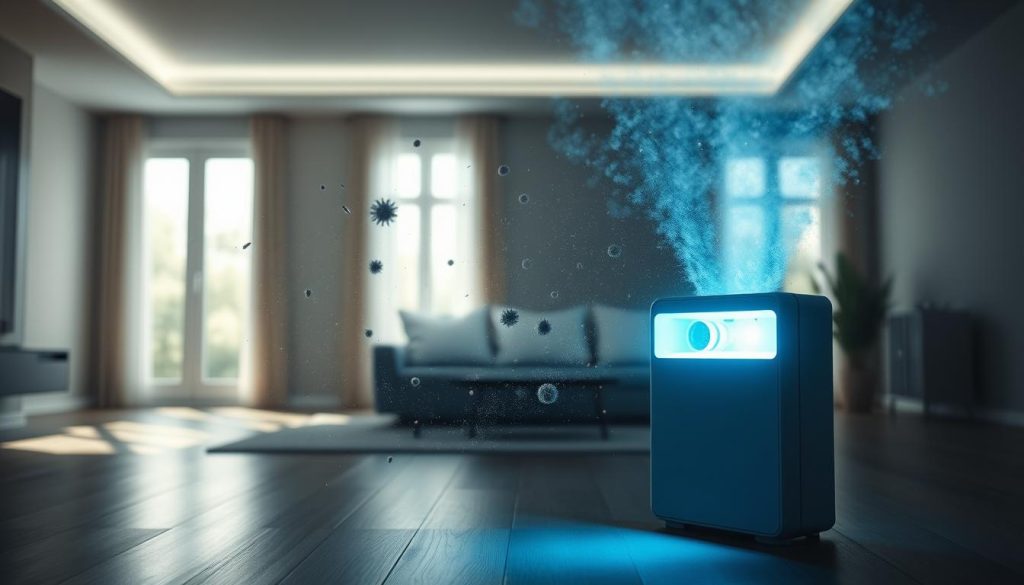When it comes to air purification and enhancing indoor air quality, most people think of air filters and ventilation systems. However, there’s another powerful tool that can help create a healthier living environment: negative ions. These tiny electrically charged particles are found abundantly in nature and have been shown to offer numerous health benefits through the process of ionization.
Negative ions are naturally generated by waterfalls, ocean waves, and even thunderstorms. They work by attaching themselves to airborne pollutants, allergens, and odor-causing molecules, effectively neutralizing them and causing them to drop out of the air. This simple yet effective mechanism can significantly improve the air quality in our homes and workplaces.
In the following sections, we’ll dive deeper into the science behind negative ions, explore their various sources, and discover how they can be harnessed to create a fresher, healthier atmosphere indoors. Get ready to learn about the surprising power of these tiny particles and how they can revolutionize your approach to air purification.
What Are Negative Ions and How Do They Work?
Negative ions are tiny, electrically charged particles that are naturally present in the air we breathe. These ionized particles are created when air molecules gain an extra electron, giving them a negative charge. This process occurs naturally in environments with moving water or air, such as waterfalls, beaches, and thunderstorms.
When negative ions are present in the air, they interact with other air molecules, including pollutants and allergens. The negatively charged ions attach to these particles, causing them to become heavier and fall to the ground, effectively removing them from the air we breathe. This process helps to purify the air and improve overall air quality.

Understanding the Science Behind Negative Ions
The science behind negative ions is rooted in the principles of electrostatics. When an atom or molecule gains an extra electron, it becomes negatively charged. In nature, this process occurs through various means, such as the movement of water or the electrical discharges during thunderstorms.
Negative ions are attracted to positively charged particles, such as dust, pollen, and other airborne pollutants. When negative ions attach to these particles, they neutralize their charge and cause them to become heavier. As a result, these particles are more likely to fall to the ground, effectively removing them from the air we breathe.
The Natural Sources of Negative Ions
Nature provides an abundance of negative ions in certain environments. Some of the most common natural sources of negative ions include:
- Waterfalls: The movement and crashing of water creates negative ions in the surrounding air.
- Beaches: The combination of moving water and salt air generates high concentrations of negative ions.
- Thunderstorms: The electrical discharges during thunderstorms produce negative ions in the atmosphere.
- Forests: The natural movement of air through trees and vegetation contributes to the presence of negative ions.
Spending time in these environments can expose you to higher levels of negative ions, potentially contributing to improved air quality and overall well-being. By understanding the science behind negative ions and their natural sources, we can better appreciate their role in promoting healthier indoor and outdoor environments.
The Benefits of Negative Ions for Indoor Air Quality
Negative ions offer a range of benefits for indoor air quality, making them a valuable addition to any home or office. By reducing airborne pollutants, neutralizing odors, and promoting a healthier living environment, negative ions can significantly improve the quality of the air you breathe.
Reducing Airborne Pollutants and Allergens
One of the primary benefits of negative ions is their ability to reduce airborne pollutants and allergens. Negative ions attach to particles such as dust, pollen, pet dander, smoke, and mold spores, causing them to become heavier and fall to the ground. This process effectively removes these irritants from the air, making it cleaner and healthier to breathe.

Studies have shown that negative ions can reduce the concentration of airborne particles by as much as 97%, providing relief for those with allergies, asthma, or other respiratory sensitivities.
Neutralizing Odors and Freshening the Air
In addition to reducing airborne pollutants, negative ions can also help neutralize unpleasant odors. Whether it’s smoke, pet odors, or cooking smells, negative ions work to break down these odor-causing molecules, leaving the air smelling fresh and clean.
This odor-neutralizing effect is similar to the fresh, clean smell you might notice after a thunderstorm, when the air is rich in negative ions. By incorporating negative ion generators into your indoor spaces, you can enjoy this fresh, clean air quality every day.
Promoting a Healthier Living Environment
Creating a negative ion-rich environment can promote a healthier living space and potentially improve respiratory health. By reducing exposure to airborne irritants and allergens, negative ions can help alleviate symptoms of allergies, asthma, and other respiratory conditions.
Furthermore, some studies suggest that negative ions may have a positive impact on mood and overall well-being. Exposure to negative ions has been linked to reduced stress levels, improved sleep quality, and increased mental clarity and focus.
By incorporating negative ion generators into your home or office, you can create a healthier, more comfortable living environment that supports both physical and mental well-being.
Do Negative Ions Reduce Airborne Pollutants?
Scientific research has delved into the air purification efficiency of negative ions, shedding light on their potential to combat indoor air pollution. Numerous studies have investigated the particle removal capabilities of negative ions, yielding promising results in reducing airborne pollutants.
One notable study published in the Journal of Aerosol Science examined the effectiveness of negative ions in removing particulate matter from indoor environments. The researchers found that negative ion generators significantly reduced the concentration of PM2.5 and PM10 particles, two common pollutants associated with adverse health effects.

Another study, conducted by the International Journal of Environmental Research and Public Health, explored the impact of negative ions on airborne bacteria and fungi. The results demonstrated that exposure to negative ions led to a substantial decrease in the presence of these microorganisms, contributing to a healthier indoor environment.
The scientific evidence supporting the air purification benefits of negative ions is growing. A comprehensive review published in the Journal of Environmental Science and Health analyzed multiple studies on the topic and concluded that negative ions exhibit a strong potential for improving indoor air quality by reducing various pollutants, including:
- Particulate matter (PM2.5 and PM10)
- Volatile organic compounds (VOCs)
- Airborne bacteria and fungi
- Allergens, such as pollen and dust mites
While further research is ongoing to fully understand the mechanisms behind negative ions’ air purification efficiency, the existing scientific findings provide compelling evidence for their ability to reduce airborne pollutants and contribute to a healthier indoor environment.
Negative Ion Generators: Enhancing Air Quality at Home
If you’re looking to improve the air quality in your home, negative ion generators can be an effective solution. These devices work by releasing negative ions into the air, which can help reduce airborne pollutants, neutralize odors, and create a fresher, healthier living environment.
Types of Negative Ion Generators
There are two main types of negative ion generators available for home use: air purifiers and ionizers. Air purifiers typically combine negative ion generation with other filtration technologies, such as HEPA filters, to capture and remove particles from the air. Ionizers, on the other hand, focus solely on releasing negative ions to neutralize pollutants and odors.

Choosing the Right Negative Ion Generator for Your Space
When selecting a negative ion generator for your home, consider the size of the space you want to treat and the specific air quality issues you’re looking to address. For larger rooms or open-concept living areas, a more powerful air purifier with a higher clean air delivery rate (CADR) may be necessary. If you’re primarily concerned with odors or smaller spaces, a compact ionizer could be sufficient.
It’s also important to choose a device that is certified by reputable organizations, such as the Association of Home Appliance Manufacturers (AHAM) or the California Air Resources Board (CARB). These certifications ensure that the product meets strict standards for ozone emission and overall safety.
Maintenance and Care for Optimal Performance
To ensure your negative ion generator continues to perform at its best, regular maintenance and cleaning are essential. For air purifiers with HEPA filters, replace the filters according to the manufacturer’s recommendations, typically every 6-12 months. For ionizers, clean the collection plates or blades regularly to remove accumulated particles and maintain optimal ion output.
By incorporating a high-quality negative ion generator into your home and following proper maintenance routines, you can enjoy the benefits of cleaner, fresher air and a healthier living environment for you and your family.
Incorporating Negative Ions into Your Daily Life
Embracing the power of negative ions in your daily life can contribute to improved wellness and a healthier living environment. Beyond using negative ion generators, there are several simple and natural ways to incorporate these beneficial particles into your routine. One effective method is to introduce houseplants into your living spaces, as they naturally release negative ions while purifying the air and enhancing your home’s aesthetic appeal.
Another way to harness the benefits of negative ions is by using salt lamps. These unique lamps, crafted from Himalayan salt crystals, emit a warm, soothing glow and release negative ions into the surrounding air when heated. Placing salt lamps in your bedroom, office, or living areas can create a calming atmosphere while promoting better air quality. Additionally, diffusing essential oils, such as lavender or eucalyptus, can not only fill your space with pleasant aromas but also contribute to the production of negative ions.
Spending time in nature is perhaps the most accessible and rewarding way to immerse yourself in an environment rich in negative ions. Taking regular nature walks, especially near waterfalls, beaches, or forests, allows you to breathe in the fresh, ion-rich air and reap the potential wellness benefits. Whether it’s a leisurely stroll through a park or a hiking adventure in the mountains, connecting with nature can help reduce stress, boost your mood, and promote overall well-being. By incorporating these simple practices into your daily life, you can create a more balanced and rejuvenating living environment that supports your health and happiness.

